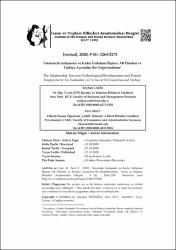| dc.contributor.author | Cafrı, Reyhan | |
| dc.contributor.author | Selci, Filiz | |
| dc.date.accessioned | 2021-07-08T07:22:13Z | |
| dc.date.available | 2021-07-08T07:22:13Z | |
| dc.date.issued | 2020 | en_US |
| dc.identifier.citation | Cafrı, R , Selci̇, F . (2020). Teknolojik Gelişmeler ve Kadın İstihdamı
İlişkisi: AB Ülkeleri ve Türkiye Açısından Bir Değerlendirme. İnsan ve Toplum
Bilimleri Araştırmaları Dergisi, 9 (5), 3264-3278.
http://www.itobiad.com/tr/pub/issue/57287/779408 | en_US |
| dc.identifier.uri | http://www.itobiad.com/tr/pub/issue/57287/779408 | |
| dc.identifier.uri | https://doi.org/10.15869/itobiad.779408 | |
| dc.identifier.uri | https://hdl.handle.net/20.500.12508/1850 | |
| dc.description.abstract | Teknolojideki gelişmeler, işlem maliyetlerini düşürerek, yeni istihdam alanları yaratarak ve daha düşük maliyetle daha fazla çıktı elde edilmesine olanak tanıyarak, ülkelerin kalkınma ve ekonomik büyümelerine katkı sağlamaktadır. Bu çalışmada, AB ülkeleri ve Türkiye’de teknolojinin kadın istidamı üzerindeki etkisi araştırılmıştır. Kadın istihdamı üzerindeki teknolojik etkinin dinamik bir olgu olmasından dolayı, bu etkinin varlığı, dinamik panel veri analizi yöntemlerinden olan iki aşamalı sistem GMM yöntemi ile tespit edilmeye çalışılmıştır. 2000-2015 dönemine ait verilerin kullanıldığı çalışmada, teknolojiyi temsilen kullanılan Ar-Ge harcamaları, yüksek teknolojili patent başvuruları ve internet kullanıcıları değişkenlerinin kadın istihdamı üzerinde pozitif etkiye sahip olduğu sonucuna ulaşılmıştır. Teknolojinin yanı sıra kadın istihdamını önemli ölçüde etkilediği düşünülen GSYH, göç, yoksulluk, hükümet etkinliği, mesleki eğitim veya staj, borçlanma ve ilkokul ve yükseköğretim seviyesindeki kadın oranı gibi değişkenler kontrol değişkenleri olarak modele dâhil edilmektedir. Kadın istihdamını etkileyen kontrol değişkenler dikkate alındığında ise, göç, yoksulluk, etkinlik, borçlanma ve ilköğretim değişkenlerinin kadın istihdamını etkilediği bulguları elde edilmiştir. Bu bulgular, ülkenin ekonomik durumunun daha iyi olduğuna dair göstergelerdeki olumlu gelişmelerin kadın istihdamını da olumlu etkilediğini göstermektedir. Ayrıca, yoksulluk oranındaki artış ve daha iyi yaşam koşullarına erişmek için meydana gelen göçün sonuçları kadın istihdamını artırmıştır. Eğitim düzeyi ile ilgili olarak, ilköğretimden mezun olan kadınların oranındaki artışın kadın istihdamını azalttığı sonucuna varılmıştır. | en_US |
| dc.description.abstract | Advances in technology contribute to the development and economic growth of countries by reducing transaction costs, creating new jobs, and enabling greater output at a lower cost. In this study, the effect of technology on women's employment in EU countries and Turkey has been investigated. Because the technological impact on women's employment is a dynamic phenomenon, the existence of this effect has been tried to be determined by the two-stage system GMM method, which is one of the dynamic panel data analysis methods. In the study, in which the data for the 2000-2015 period is used, it has been concluded that the variables of R & D expenditures, high-tech patent applications, and internet users, used as representing the technology have a positive effect on women’s employment. In addition to technology, variables such as GDP, migration, poverty, government efficiency, vocational training or internship, borrowing and proportion of women in primary and higher education which are thought to have a significant impact on women's employment are included in the model as control variables. When the control variables that affect women’s employment are taken into consideration, it is found that migration, poverty, efficiency, borrowing, and primary education variables affect female employment. These findings indicate that positive developments in indicators that the country's economic situation is better also affect women's employment positively. Furthermore, the results of the increase in the poverty rate and migration to access better living conditions have increased women's employment. In relation to the level of education, it is concluded that the increase in the proportion of women graduating from primary education reduces the employment of women. | en_US |
| dc.language.iso | tur | en_US |
| dc.publisher | İnsan ve Toplum Bilimleri Araştırmaları Dergisi | en_US |
| dc.rights | info:eu-repo/semantics/openAccess | en_US |
| dc.subject | Teknoloji | en_US |
| dc.subject | Kadın istihdamı | en_US |
| dc.subject | Sistem GMM | en_US |
| dc.subject | Ar-Ge | en_US |
| dc.subject | Patent | en_US |
| dc.subject | Technology | en_US |
| dc.subject | Women's employment | en_US |
| dc.subject | The system GMM | en_US |
| dc.subject | R&D | en_US |
| dc.title | Teknolojik Gelişmeler ve Kadın İstihdamı İlişkisi: AB Ülkeleri ve Türkiye Açısından Bir Değerlendirme | en_US |
| dc.title.alternative | The Relationship Between Technological Developments and Female Employment: An Evaluation in Terms of EU Countries and Turkey | en_US |
| dc.type | article | en_US |
| dc.relation.journal | İnsan ve Toplum Bilimleri Araştırmaları Dergisi | en_US |
| dc.relation.journal | Journal of the Human and Social Sciences Research | |
| dc.contributor.department | İşletme ve Yönetim Bilimleri Fakültesi -- Uluslararası Ticaret ve İşletmecilik Bölümü | en_US |
| dc.contributor.authorID | 0000-0002-6271-5330 | en_US |
| dc.contributor.authorID | 0000-0003-4033-5836 | en_US |
| dc.identifier.volume | 9 | en_US |
| dc.identifier.issue | 5 | en_US |
| dc.identifier.startpage | 3624 | en_US |
| dc.identifier.endpage | 3278 | en_US |
| dc.relation.publicationcategory | Makale - Ulusal Hakemli Dergi - Kurum Öğretim Elemanı | en_US |
| dc.contributor.isteauthor | Cafrı, Reyhan | |
| dc.relation.index | TR-Dizin | en_US |
















